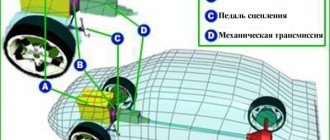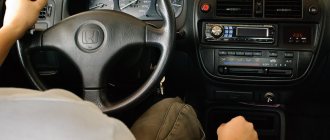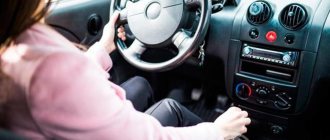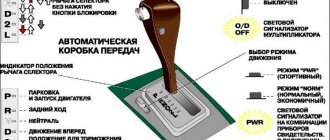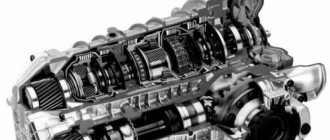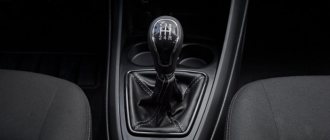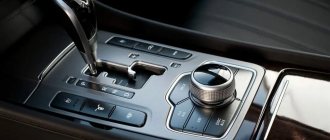When you get behind the wheel for the first time, even a confident person gets nervous. Therefore, it is important to know theoretically how to properly learn to drive a manual car. Then the instructor’s explanations will not seem like something supernatural. The SAI Driving School will talk about how to learn to drive a manual car, and we will study all stages of movement and braking.
Important Notes
Before you get behind the wheel, you need to study the structure of the car, the traffic rules, and find out where the controls are located. Information about possible malfunctions and rules for providing first aid will not be superfluous. Anything can happen on the road. After studying the topic of driving, you can begin practical lessons.
Let's consider the most correct options for learning to drive with a manual transmission
Today we want to tell you, friends, how you can quickly learn to drive a car with a manual transmission (or a manual or standard transmission). After studying our manual in detail, you can easily start a car with such a gearbox, make it move off smoothly and then drive it, and also switch between gears on the go without any problems. Don't be discouraged if you don't succeed right away. Many of us in the editorial office also didn’t immediately get used to the manual box, but believe us, it’s worth it!
First of all, practice, practice and more practice! Good luck to everyone, gentlemen!
At the end of our article you will find the most frequently asked questions about a manual transmission and basic tips on how to drive such a mechanic.
Advantages of manual transmission
By default, driving a car of any category with a manual transmission has the following advantages:
- the cost of a car is cheaper with a similar configuration;
- traffic safety increases, since in an emergency you can brake with the engine;
- the user independently chooses the driving style;
- the operating budget of a manual is significantly lower than that of an automatic;
- the mechanics can be started “from the pusher” downhill with a discharged battery;
- design and maintenance are as simple as possible, there are no expensive consumables;
- Maximum efficiency, long-distance towing is allowed;
- for ice, dirt roads and mud this is the best option;
- acceleration dynamics are higher, and the weight of the unit is less than that of an automatic transmission.
A car with an automatic transmission is difficult to tow
It is better to undergo training on a more complex manual transmission, and then get used to an automatic transmission in a few hours, and not vice versa.
Mechanics for beginners.
Seven steps to your first ride in a manual car.
- 1. Find a good paved area where there are no people around so you can practice driving.
- 2. While the car is not started, examine the gears on the box.
- 3. Depress the clutch and start the engine.
- 4. Shift the gear to first gear.
- 5. Slowly release the clutch until the car begins to move gradually.
- 6. Your left foot is still on the clutch, now add a little gas by pressing the pedal with your right foot until the tachometer reads 1000 or 2000 rpm.
- 7. Now slowly release the clutch, but your right foot should still be on the gas pedal. If you press the gas pedal sufficiently, the car will start moving forward.
Stopping and parking
To silence vehicles, you can use two options:
- Switching to lower gears, you must then depress the brake pedal.
- Press the clutch and move the selector to the neutral position, then remove your foot from the clutch and apply the brake, if necessary.
To reduce wear on the gearbox, it is better to use the second method, and do not forget to depress the clutch in addition to the brake.
When parking your car, you should always use the handbrake, especially if the surface is sloped. It is also always worth remembering the position of the wheels when parking. They need to be turned in such a way that in case of sudden movement, the car does not end up on the roadway.
Also, for greater safety, it is recommended to move the selector to first gear. This will help protect the car from accidental rolling. But when resuming movement, you need to remember that the selector must be moved to neutral. And only then start squeezing the clutch.
Today, some new car enthusiasts prefer cars with automatic transmission, considering them easier to drive. But it is worth remembering that the mechanics were and remain the most reliable. Greater control over the vehicle, increased power and fuel savings will reward its owner for choosing a manual transmission. And having gained experience, driving such cars will be a pleasure.
How I learned to drive a car with a manual transmission
I always dreamed of learning to drive a car with a manual transmission because I thought it was cool. When I got my first manual car in 2012, I couldn't wait to get behind the wheel of my first car. I read and looked at some instructions and thought that learning to ride would not be that difficult. How wrong I was, my friends. My car has a 412 hp Coyote engine. With. and the 390 Nm torque was difficult to control. I drove the car left and right.
My problem was precisely that all the instructions I read that I found on the Internet taught me to "lower and smoothly lower the clutch." I did so according to the instructions, but the car still shook. In the end, I realized my mistake; I didn’t have to press the gas for the car to move. Depending on the speed at idle, namely when you do not press the gas pedal, you just need to release the clutch a little and the car will move by itself.
I played a little and practiced without moving with the clutch and felt that so-called clutch moment, that is, when the car starts to move, and the clutch at that moment asks to add more gas. At this very moment you feel a slight resistance and vibration from the clutch pedal; The car starts asking for more gas to move further, so that I completely release the clutch. When I tried and tested this new method of starting, I was able to start the car and pull away very smoothly. It's too bad no one told me about this before.
Basics
A manual car has 3 pedals . They are located like this:
- The far left is the clutch pedal;
- In the middle is the brake;
- The far right is gas.
The most important thing is to understand the principle of operation of the clutch pedal and how to change gears correctly. Learning and honing the skill of shifting gears on a manual transmission is best done with the car running. Learning to press and release the clutch pedal smoothly is also very important, otherwise the car will constantly stall.
It's worth understanding how this works. Using the clutch pedal, we control the engagement of gears that go from the engine to the shaft. When the pedal is fully pressed, we can safely change gears without fear of damaging the mechanism. How far you release the pedal affects how much grip you have. So we can highlight several pedal positions, the knowledge of which we will have to master through experience, but it is necessary to know about them:
- When fully pressed, the clutch is disengaged;
- The position of the slightly released pedal is the coupling point. For each car, this and subsequent positions are purely individual, but in a properly configured car, the coupling point is closer to the vertical position of the pedal, relative to the bottom;
- The position of the pedal being slightly pressed, closer to the pedal being released, is full clutch. The car drives in this position.
- The pedal is released - the clutch is also fully engaged. The range of motion from the pedal being fully released to being slightly pressed is called empty stroke. Here the car moves according to the selected gear, all that changes is the clutch force.
When you start the car, the clutch must be disengaged, that is, the pedal must be pressed all the way down. Only after first gear is engaged and the engine is running can we smoothly release the pedal to start moving. Driving a car for mechanics is not difficult, but this process has its own specifics.
Don't forget to adjust the mirrors and position the seat in such a way that you can easily press the pedals all the way. Don’t forget to buckle up, because in the first place you will often stall, as a result of which you can hit the steering wheel and generally get injured. Safety comes first.
Adjust your mirrors
Adjust your side and rear view mirrors so that you can see what is happening behind you and to the sides. Make sure you are in an area where no one is around and there is enough road ahead of you that you can drive the car at different speeds without crashing into anyone.
Explore the gearbox
When the engine is not yet started, move the gearshift lever. The speeds on the lever are arranged in an "H" shape. However, the return stroke in the box will be located differently in different levers. In this case, such a reverse move is to the right and down.
Learning pedals
The far left one seems like a pedal - it’s not a pedal at all, it’s the place where you can put your foot while moving. The clutch pedal is the second from the left. Next comes the brake pedal and the far right is the gas pedal.
What can't you do in a car with a manual transmission?
You should start driving a manual car carefully and carefully. Although mechanical boxes are considered the most durable and hardy, they quickly break down due to violations of operating rules. Each mechanism has its own weak point, so remember what you cannot do with manual transmissions:
- Switch to reverse if the car has not stopped completely (the gearbox breaks);
- Depress the clutch pedal more often than necessary to change gears (increases wear on the linings and release bearing);
- Do not fully depress the clutch when changing gears or simply hold your foot on this pedal (accelerates wear on the linings and transmission);
- Change gears if the speed is not suitable for this (it breaks the gearbox synchronizers and overloads the motor);
- Keep the clutch depressed for more than 40 seconds (increases bearing wear), it is better to engage the neutral stage;
- Releasing the clutch pedal sharply (wear of the engine, transmission and clutch parts at once);
By following the operating rules and learning to smoothly change gears at the right moment, you will understand that driving a manual gives you complete control over the car, which is very important in any driving situation. Unlike automatics, the “Urka” - overdrive mode, the mechanical one does not have an analogue.
How to start a car in neutral gear
To start the car, the lever in the gearbox must be at neutral speed (the horizontal part of the lever), and the clutch pedal must be kept pressed (squeezed) at all times. This is to make sure that you are exactly in neutral (shake the lever a little).
And so, to start the car, press the clutch pedal, hold it down and turn the key in the ignition. Before releasing the clutch, make sure the car is in neutral. Neutral gear in the box is marked directly on the lever with a horizontal line. You can safely check whether your gear is in neutral at this moment. To do this, you need to slightly swing the lever left and right. If the lever moves, you are in neutral.
See also: How does a gearbox work in a car?
Well, now the engine is running, you are still sitting, doing nothing and not going anywhere, which is not so bad for a start.
Adviсe
So, how to start the mechanics and what tips will help with this? The key to driving a manual vehicle is also efficiency. As for the gearbox, you need to drive in the highest possible gear. This will reduce fuel consumption and limit friction of parts, avoiding constant gear changes. Therefore, it is important to know how to start a car manually for beginners.
When starting off, keep the brake pedal pressed. This is necessary for security reasons. Also, make sure the gear shift lever is in neutral. Turn the key almost all the way and it will return to the ignition position.
Last but not least, it is recommended to operate the steering wheel with both hands, as many people are used to driving with their right hand holding the gear lever. This ultimately leads to more wear and increased clearances in internal parts and mechanisms.
It is important not only to know how to start a car with an automatic transmission, but also some life hacks for using this gearbox. For example, you should never go from the letter "D" to "R" while moving. If you do this at low speed, nothing will probably happen, but if you don't wait until the vehicle comes to a complete stop to make this shift, it will put extra stress on the drive belt due to wear.
Above you can find out how to properly start a car with a manual or automatic transmission. The above information will also tell you how to start a car for manual beginners. If you want to take car driving courses in Moscow, we recommend that you study our offer using the link given here.
Shifting to first gear
Hold the clutch and shift the lever to first gear. Usually this is a movement to the left and up from yourself.
Now further, while holding the clutch pedal, switch the gearbox lever to first speed, that is, to the left and away from you.
Just don't drop the clutch, otherwise the car will stall! Don't worry friends, you will definitely learn this over time!
Car parking
Parking a car should be part of the basics of driving for women, because they are worse at it. No exceptions should be made for men; collisions during parking are the most common type of accidents. It would seem that this is not a difficult maneuver, but most novice drivers make mistakes. The following sequence must be strictly observed:
- Look for a place to park your car. It should not interfere with the movement of other vehicles or pedestrians;
- Pull into a parking space, release the clutch and brake;
- Switch the gears to neutral, release the clutch;
- Turn off the ignition, stopping the engine;
- Secure the car with the handbrake;
- Release the brake pedal;
In winter, it is recommended to use manual gear instead of setting the handbrake. This allows you to avoid spontaneous rolling of the car, and will prevent the pads from freezing (we avoid problems with the brakes in the morning). When parking on a slope, you should turn the steering wheel so that the wheels of the car rest against the curb. If there is no curb, the wheels are turned towards the curb. This allows you to avoid accidents.
Hand brake
Some cars have a handbrake, parking brake, or brake control button (see above). Many other machines have a lever with a release button.
So, the car is moving. Now you need to make sure the handbrake is off. Since you are driving on a flat road, your car will not roll away while you are thinking about what to do next.
How to drive a car for the first time after getting a license?
After getting their license, new drivers are nervous about driving on their own. Previously, an instructor drove next to them, who could provide backup in a serious situation, give advice and even stop the car. Now you have to go rely only on your knowledge and skills, and be responsible for the passengers in the cabin. You should travel using simple tips for beginners so that the first trip does not turn into torture:
- When buying a car, you should bombard the seller with questions - the features of the car, the location of the control elements, find out everything about the car that might be useful to you;
- There is no need to drive like a dashing horseman; when you first drive out, you still don’t understand how the car will behave at speed and how quickly you can brake;
- You should drive slowly, noting the car’s reactions to any of your actions with the controls;
- If possible, you should avoid driving on very busy roads on the first day;
- You should drive while looking in the rearview mirrors periodically, especially before performing any maneuver;
- You should not turn on music while driving, it does not calm you down, but only distracts your attention;
IMPORTANT: Now the most dangerous for you are not cars, but drivers of mopeds, bicycles and ordinary pedestrians. In front of a car, they can behave as unpredictable as a monkey with a grenade. Cyclists and mopeds can ride behind and unexpectedly jump out from the side. Most of them barely know how to drive, and have only heard about traffic rules. When approaching pedestrian crossings, regardless of the traffic light, slow down and keep your foot close to the brake pedal. If a pedestrian or cyclist suddenly jumps out, you can brake, gaining a couple of saving seconds.
How to start driving while driving a car with a manual transmission, see the material written a little below.
Release the clutch and give gas
Release the clutch until you feel the car begin to move forward a little. Press the gas pedal until the tachometer on the instrument scale shows 1,000 - 2,000 rpm.
When you are driving in first gear, start slowly and gradually release the clutch until you feel that the car has started to move forward as before. This is the most difficult thing, gentlemen!
You must learn to feel this very moment of grip when the machine begins to vibrate a little. Practice until you can automatically feel this moment, then thanks to this it will be easier for you to learn to drive a manual.
Slowly, gradually increase the gas by pressing the appropriate gas pedal. Pressing the gas pedal should be sufficient for the tachometer needle to stop between 1 (one) and 2 (two), that is, between 1000 and 2000 rpm. If you give too little gas, your car will stall. If there is too much gas, you will start to burn the clutch at that moment. This often happens to novice drivers, however, friends must remember, if this happens all the time, then over time the clutch in the car may wear out.
How to get started
If you are driving for the first time, then it is better to choose a place where there are no other cars or pedestrians, so that you can calmly, without prying eyes and fuss, learn how to drive a car. There are special racing tracks where anyone can hone their driving skills to perfection.
The first thing you see when you get into the car is the neutral is on, the handbrake is on. There is a simple procedure that you can follow to get started:
- Start the engine;
- Depress the clutch pedal all the way;
- Engage first gear. Most often, it is located in such a way that you will need to move the lever first to the left, then forward, in order to “stick” it;
- Remove the car from the handbrake;
- Holding the clutch with your left foot, lightly press the gas with your right, raising the speed to 1.5-2 thousand. This will prevent the car from stalling. The number of revolutions is displayed on the dashboard, on the so-called tachometer;
- Gradually release the clutch pedal to the gripping point. The car should start moving, as soon as this happens, stop releasing the pedal and fix it in this position;
- As soon as the car begins to move fully, smoothly release the clutch pedal and, if necessary, add gas.
When starting to move, it is worth considering the position of the car. If you are standing uphill, the procedure will look different. This is what the procedure will look like if you want to drive uphill without a handbrake:
- We stand with the clutch and brake depressed, first gear engaged;
- Smoothly release the clutch pedal to the grip point. When the coupling occurs, you will see that the revolutions have dropped slightly;
- Now release the brake with your right foot and press down on the gas pedal, give 2 thousand revolutions, if the hill is steep, then more. The car starts moving uphill
Release the clutch after shifting into gear
When you have already added a little gas, try not to rush to completely release the clutch. Release it the moment you feel the next speed engage. You can tell by the slight vibration you feel in your feet, which comes directly from the clutch pedal. When this moment comes, you can completely release the clutch and calmly continue driving, just like in a car with an automatic transmission.
Congratulations gentlemen! You started a car with a manual transmission! For me, learning to drive a manual car couldn't have been easier once I learned about that clutch moment and how it can be felt. I believe this is the easiest way to learn to drive a manual car.
Video: how to drive a manual car
In this video, you friends will see which parts of the car you need to become familiar with, how to release the clutch pedal and how to press the gas pedal.
To switch from first to second speed, you need to press the clutch and pull the lever down towards you. And to switch to third speed, you need to press the clutch pedal again and pull the shift lever up and to the right.
It seems to me that changing gears on the gearbox is much easier than trying to start the car. Just look at the lever and learn all the speeds on it for yourself. You switch from 1 to 2, then to 3, 4, 5 and 6 speeds (if the car has six speeds).
How to switch to the highest speed? It's almost the same as starting a car, only much easier.
Let's assume, gentlemen, that you are driving in first gear and are about to shift to second gear. Here are your steps:
- 1. Press the clutch, then shift the gearshift lever to second gear. In most cars, to change from first gear to second, you need to pull the lever towards you.
- 2. Slowly release the clutch until it engages, then add gas.
- 3. Release the clutch pedal and continue driving.
The transition from second to third and then to fourth gear is the same, and even easier. To make this transition absolutely smooth, you will have to learn to balance the clutch and gas well. But all this, friends, comes naturally with practice.
Why is it better to learn driving with a manual?
In the 21st century, driving a car is the equivalent of being able to ride a bicycle in the 20th century. Moreover, it is better to carry out training in a car with a manual transmission for a number of reasons:
- a manual gearbox is more difficult to master;
- even when buying a car with an automatic transmission, you may get caught with a mechanic when renting on vacation or in another city;
- Having learned to change gears manually, it is easier to master a CVT, automatic or robot.
The AT mark is placed in paragraph 14 on the back of the driver’s license
Attention: When passing the practical part of the traffic police license exam in a car with a mechanic, the motorist is allowed to drive category B vehicles with any gearbox (automatic, CVT, robotic and manual). The rest of the car enthusiasts have to change to a manual, they will have to retake the driving test.
Switch to overdrive when the engine reaches 2,500 thousand rpm
To move from first gear to second and higher, you need to monitor the tachometer readings. When the arrow points to 2500 - 3000 rpm, the car's engine is ready to shift to a higher gear.
How do you know when to change gear? Here you need to look either at the number of revolutions per minute, or at the speed at which you are moving. Typically, gear changes occur at 2500 - 3000 rpm.
As for speed and gear shifting, it all depends on the car, so read the instructions for your car. In general, speed is not as important for upshifting as it is for downshifting.
Over time, you friends will learn to understand by the sound of the engine itself and by the general behavior of the car on the road when you can change one gear or another.
The most frequently asked questions about manual transmission.
What should you consider before leaving?
Anyone who has started studying for a license will have their first driving lessons in a manual car. You need to check the following details before leaving:
- Make sure you have your driver's license and MTPL insurance with you. Even drivers with many years of experience forget their documents, so they pay fines when meeting with traffic police officers;
- It is important to check that the brakes are working properly every time;
- So that all side lights are lit;
- All the lights worked, including the rear ones;
- The steering worked properly;
- The wiper on the driver's side was working;
IMPORTANT: According to the laws of the Russian Federation, it is prohibited to travel without documents or when any of the above elements do not work, even to the place of repair! This is the case when you will have to pay fines for violating the rules.
Advice to all novice drivers who drive not only manual ones - before leaving, especially when the trip is long, check:
- The amount of coolant in the system;
- Is there enough gasoline in the tank?
- Motor lubrication level;
- Pressure of all tires/tyres;
How to start a car with manual transmission?
- 1. To start the engine, you must first go into neutral. This is the marked horizontal line on the gearshift lever. Rock the lever itself a little to make sure that the gear is in neutral.
- 2. Also make sure that the handbrake is engaged.
- 3. Please note that some cars will not start in neutral unless you keep the clutch pedal (left pedal) depressed.
- 4. Turn the ignition key.
- 5. You started the car!
What to check before leaving
Before leaving home, check the availability of documents, without which you cannot drive the vehicle.
External inspection of the car
1. Body. There may be snow, leaves, dirt, etc. on the car. - clean if necessary. 2. Wheels. If, during inspection, a fact is revealed that the tire is “low”, you will need to pump it up, for example, yourself or go to a tire repair shop.
Important: The tire pressure must be the same.
3. Mirrors, glass (windshield, side, rear). They must be clean. Nothing should interfere with the view when the car is moving. 4. Headlights. If dirty, clean it.
Internal inspection of the car
1. Driver's seat. It should be customized to your parameters. 2. Overview of side mirrors and rear view. 3. Make sure the car is at “neutral speed”. The lever should move freely.
How to drive a car with a manual transmission?
- 1. After you start the engine, try to keep the clutch depressed.
- 2. Shift the gearshift lever to first gear, that is, to the left and away from you.
- 3. Release the handbrake or parking brake.
- 4. Slowly release the clutch pedal and add gas. Watch the tachometer needle. You can fully release the clutch when the needle shows 1000 - 2000 rpm.
- 5. Continue driving in first gear.
- 6. If your car stalls, then raise the handbrake, then press the clutch pedal, and then move the lever to neutral and start the engine again.
Lifehacks for beginners: getting started on a slope
Hills that are found on city and country roads cause certain difficulties for beginners. Because of the upward slope, many are afraid to start moving after a forced stop. Especially if there is a car behind.
In order not to get confused or scared in such a situation, practice driving uphill. For this:
- Press the clutch and shift into first gear.
- Lightly press the gas pedal as you begin to release the clutch.
- At the same time, raise the handbrake lever a little more without pressing the buttons on it.
- At the right moment, release the handbrake so that the car moves forward.
The engine speed should be higher than during a normal start, but not too high so that the car stalls. In this way you can start moving even on a steep climb.
Are you afraid that you won't be able to learn to drive? Contact the Moscow “Driving School 177”. Our instructors will teach you how to start in different conditions. Students can use a special training area to practice skills in a relaxed environment.
My car stalled. What to do?
First of all, you need to calm down. There's nothing wrong with your car and you haven't broken anything. Simply press the clutch pedal again and turn the ignition key. Your car will start again. Just make sure for yourself first that the shift lever is in neutral and perform the same steps again.
See also: Double Clutch Shift Pattern, Why Use It, How It Works and How to Apply It in Everyday Situation?
Why did the car stall? You put the lever into first gear but did not give enough gas to move the car. The car wanted to go, but it didn’t have enough gas and it stalled.
Manual transmission control
The manual transmission is controlled using the clutch, as well as the gear shift lever. Each gear corresponds to a specific lever position. A novice driver needs to remember the correspondence between gears and lever positions. You need to learn how to change gears without being distracted from the road and without thinking about which gear is currently engaged. Start the car, but first make sure that your gear shift lever is in neutral. Press the clutch all the way to the floor and move the lever to the first gear position. Then, lightly pressing the accelerator pedal, quickly but not abruptly release the clutch, holding it for a few seconds in the middle of the pedal stroke. If you followed the instructions exactly, your car will drive smoothly, without shaking and without engine roar.
Having developed the speed necessary to change gear, depress the clutch again, change gear, and then release the clutch. Having engaged the gear, simultaneously release the clutch and gently press the accelerator. You should change gears one by one (from first to second, and so on).
When reducing speed, you should shift in accordance with the speed limit. The operating interval for most manual transmissions is as follows: first gear from 0 to 20 km/h; the second from 20 to 40 km/h; third from 40 to 60 km/h; fourth from 60 to 80 km/h; fifth from 80 to 150-200 km/h.
How can you choose the speed and engine speed at which the required gear will be engaged?
Let's give an example: in first gear you can accelerate the car to 30 km/h, and when you switch to second gear, you should do so at a speed of 10 km/h to 30 km/h. For example, at 18 km/h, you can smoothly shift into second gear without your car jerking.
Also, when operating a car with a manual transmission, remember: the lower the gear, the more powerful it is, but the lower its maximum and minimum permissible speeds. That is why, when moving from a standstill and climbing to a hill, you should engage 1st or 2nd gear. Therefore, 3rd, 4th, 5th should be used when traveling at higher speeds, when exiting a slope. Proper gear shifting will make your ride pleasant, free of unpleasant jerking and deafening engine roar at high speeds.
The lower the gear, the more powerful it is, but the lower its maximum and minimum permissible speeds.
The main thing to remember is that you should never engage reverse gear while moving forward. This will certainly lead to an accident or failure of the manual transmission. To prevent this, most modern cars have reverse gear lockers installed.

